Mitsubishi Pajero 2013 News
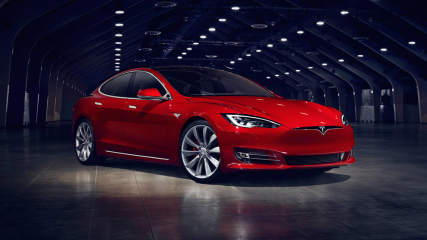
Tesla Model S and X, Merc C-Class, Mitsubishi Pajero and Range Rover Sport recalls
Read the article
By Tim Nicholson · 21 Apr 2017
Tesla has issued a voluntary recall for its electric Model S sedan and Model X SUV after discovering a potential manufacturing issue that could stop the electric park brake from functioning properly.
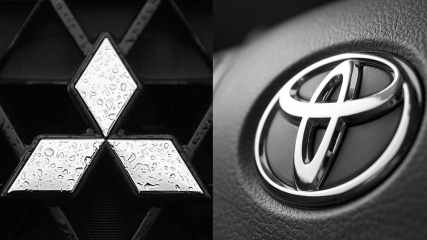
800,000 cars recalled in two days
Read the article
By Joshua Dowling · 30 Jun 2016
Cars are either being built worse -- or companies are getting better at detecting faults.a range of models made over the last 10 years replacing potentially deadly Takata airbags in 1.3 million cars in Australia. a second, airbag-related recall for the Priusreplacing potentially deadly Takata airbags in 1.3 million cars in Australia
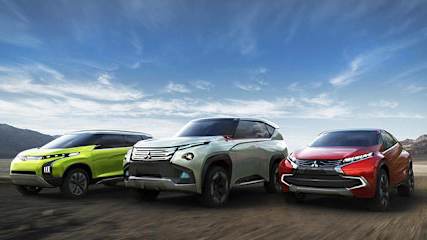
2015 Mitsubishi Pajero and ASX style hints
Read the article
By Karla Pincott · 05 Nov 2013
The next-generation Mitsubishi Pajero is on the way -- perhaps as early as next year -- along with Triton and Lancer. But we could be getting an early look at the SUV's styling with a trio of concept vehicles the manufacturer says point to the direction the brand's development and manufacturing will take in the near future.The Concept GC-PHEV, Concept XR-PHEV and the Concept AR will be unveiled at the Tokyo motor show later this month, revealing new design explorations and technology that could appear on future vehicles.The 'Grand Cruiser' Concept GC-PHEV large SUV hints at the possible direction for the coming Pajero replacement, running the Japanese manufacturer's full-time all-wheel drive set-up and showcasing new safety and communication technology. Under the bonnet is a plug-in hybrid system with an electric motor and high-capacity battery pack plus a 3.0-litre V6 supercharged engine, with an eight-speed auto.The smaller 'Cross Runner' Concept XR-PHEV is a compact SUV with possibilities for the next-generation ASX or Outlander -- both of which would have to wait for the 2014 update to the Lancer on which they're based. The front-wheel drive plug-in is powered by a turbocharged 1.1-litre direct-injected engine, again matched to a small high-efficiency motor and high-capacity battery.The final of the trio, the small hybrid 'Active Runner' Concept AR is a multi-purpose/peoplemover design, also carrying a turbo direct-injected 1.1-litre engine and electric motor.More details on the concepts' specification -- and perhaps future plans for them -- will be revealed around show time, where the concepts will be among the 17 vehicles on the Mitsubishi stand.This reporter is on Twitter: @KarlaPincott
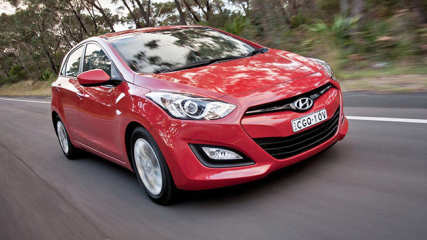
Korea is beating Japanese brands
Read the article
By Paul Gover · 25 Sep 2013
That might sound like a silly answer to a serious question, but it's the best solution for optimum shopping in the back end of 2013. You see, Korea now makes better Japanese cars than the Japanese. And that's a fact.There are some exceptions, and some categories where the Koreans are still getting a foothold, but a Hyundai i30 or a Kia Cerato is a far better choice than a Mitsubishi Lancer, a Kia Sportage makes more sense than a Honda CR-V, and a Hyundai Santa Fe is much better buying than a Toyota Kluger.This Korean tide has been rising for a while, but it's now filled showrooms with quality cars that are backed by industry-leading five-year warranties with capped-price servicing costs. The two Korean juggernauts are also serious about tuning their cars for Australian drivers and roads, which is becoming a serious selling point and also a battlefield for bragging rights between Hyundai and Kia.Even Daewoo, which was absorbed into the Holden empire to provide cut-price cars such as the Barina and Captiva, is now doing a better job as the engineering and design expertise from Fishermans Bend is absorbed deeply into the Korean content on the cars. And don't forget that the Aussie-made Cruze compact, despite its local tweaking and assembly in Adelaide, began its life at the GM Daewoo division in Korea.Without getting into a history lesson, the seismic shift between Japan and Korea comes down to three things. First is the deep-seated rivalry between the two countries, second is the well-lit path to success blazed by Japanese makers including Honda and Toyota, and third is the Global Financial Crisis. How's that?Well, nothing makes a Korean businessman happier than beating a Japanese rival, even though the Japanese were the first Asian companies to achieve success in motoring thanks to cars like the Toyota Corolla, Honda Civic and the classy machines that followed. These days, the Nissan GT-R is a legend and the Toyota LandCruiser is an icon.So the Koreans assimilated the Japanese business model for cheap, reliable and sensible cars - think of the Hyundai Elantra and Kia Rio - and then found a way to build them with similar quality at a lower price. There was a time when the cabins of Korean cars stank - because of the 'release agent' applied to plastic parts - and the assembly was slipshod and downmarket, but not today. They also have aircon with Japanese efficiency, always a pointer to intelligent engineering in Australian weather.But it's the GFC which has made the biggest difference. While the Japanese brands panicked, cutting costs and stretching the lifetimes of their cars, the Koreans accelerated their development plans, brought new models, and invested in their dealerships in Australia.The results are obvious now as many Japanese cars - we're talking about the Honda Civic and Subaru Impreza - have lost their previous edge, while others - think Mitsubishi Pajero and Subaru WRX - are way overdue for a remake.In the meantime, Hyundai is now plotting a move upmarket with its luxury Genesis models and Kia is setting a global standard for quality styling thanks to its recruiting of design genius Peter Schreyer. Best of all, when you're buying, it's the driveaway pricing that's been a Korean signature since Hyundai blazed that trail in the 1990s to get nervous shoppers over the line.This reporter is on Twitter: @paulwardgover

New car sales price Mitsubishi Pajero
Read the article
By Ewan Kennedy · 01 Jul 2013
Mitsubishi Pajero is an important vehicle in the history of 4WDs in Australia. Prior to the Mitsubishi’s launch in the early 1980s buyers could choose between a 4WD that was truck-like, or find a lot more money and go for a very expensive Range Rover. Then Pajero arrived at an affordable price, with good off-road ability, on-road comfort and decent handling.The rest, as they say, is history and in the intervening four decades every car maker in the world has designed 4WDs and SUVs based on the principles introduced by Mitsubishi for its now-renowned Pajero.Now, Mitsubishi Pajero has been updated for the 2014 model year and Australians, who have bought it in the tens of thousands have an even better vehicle. For the 2014 season there’s a big emphasis on safety, with luxury items also being added and/or upgraded.TECHNOLOGYMitsubishi’s Link in the GLX and GLX-R provides voice controlled Bluetooth 2.0 with steering wheel controls, mobile hands-free and wireless audio streaming making it easier and safer to conduct business or enjoy some downtime in the Pajero. The VRX and Exceed receive the addition of the Mitsubishi Multi Communications System (MMCS incorporating 3D based satellite navigation) and rear-parking sensors.The entry-level, five-seat diesel Mitsubishi Pajero GLX has keyless entry; 17-inch alloy wheels; front skid plate; rear fog lamps; roof rails and wheelarch flares. Inside, there’s a leather-trimmed steering wheel and shift lever; automatic climate control; and a multifunction trip computer.The GLX’s audio system has a single-CD player, six speakers, USB port with iPod control interface and AUX audio input so you can listen to your favourite music in any format. Voice controlled Bluetooth 2.0 with steering wheel controls, mobile hands-free and wireless audio streaming make it easier and safer to conduct business or enjoy some downtime in the Pajero.Next up the luxury line, the Mitsubishi Pajero GLX-R also gets colour-coded door mirrors and door handles; a rear tailgate spoiler; integrated side steps and front mudguards; front foglamps and black door sash detail.The Pajero GLX-R’s versatile seven-seat setup offers multiple options, with the third-row seat able to fold, drop or recline, it can even be stowed under the cargo floor, or totally removed. Automatic climate control is part of this package.The mid-range, seven-seat diesel Pajero VRX now has 18-inch alloy wheels; a restyled chrome radiator grille; darkened rear privacy glass, exterior door mirrors with built-in turn signals and puddle lamps. Inside, Pajero VRX’s cabin receives partial leather seat trim and leather look floor and console and door trims for added style, while the power adjustable front seats with seat heaters increase comfort levels.The all-new Mitsubishi Multi-Communication System (MMCS) found in the Pajero VRX features a high-resolution touch-screen panel with 3D satellite navigation for easier operation. The top of the range Pajero Exceed receives chromed details on the door mirrors and handles; chrome side strips and front foglamps with chrome bezels to brighten the exterior appearance. The added brightness of High Intensity Discharge (HID) headlamps come as standard on the Exceed.Inside, the Exceed comes with leather seat trim and stylish wood print to give it a luxury look. Entertainment comes from a quality 860 watt, 12-speaker Rockford Acoustic Design audio system. The kids get a rear seat 9-inch DVD entertainment system with dual wireless headphones.Crash prevention is the best form of safety. The Mitsubishi Pajero is equipped with MATT (Mitsubishi All Terrain Technology) for excellent off-road control, it also improves on-road safety and handling. A rear differential lock is standard across the range.SAFETYThe MATT system incorporates Active Stability and Traction Control, ABS braking system with EBD and Mitsubishi’s well proven Super Select II 4WD layout. This lets the driver switch between 2WD and 4WD modes at speeds of up to 100 kilometres per hour on any surface. Thus making for the best compromises of on-road fuel efficiency, off-road traction and many other areas between these extremes.Standard injury minimisation safety equipment on all variants of the Pajero includes front driver and passenger, side and curtain SRS airbags and IsoFix child restraints (the latter from July 2013 onwards).WARRANTY AND SERVICINGMitsubishi Australia continues to give a five year/130,000km new vehicle warranty and five year Roadside Assist. There’s capped price servicing for the first four years or 60,000km of ownership on all new vehicles. There are some conditions attached to the servicing so contact your Mitsubishi dealer to discuss your particular situation.
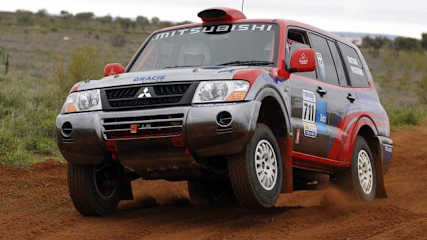
Pickering keeps grip on Finke class crown
Read the article
By CarsGuide team · 12 Jun 2013
Pickering triumphed in the recent bone-rattling Finke Desert Race, marking a record 11th consecutive class victory, and putting him in position for a Production 4WD trophy.Pickering took his Mitsubishi Pajero to first in class among a field of 99 vehicles, many of which were purpose-built offroad racers.He and co-driver Dylan Watson finished the tough 452km desert circuit from Alice Springs to Finke and back in a time of 6hr21m47s in what Pickering says was one of the toughest races in the event’s 38 years – with about half the entrants failing to make the finish line.Pickering says preparation of the barely modified 3.8-litre V6 petrol Pajero was the key to his record success. "Our Pajero was extremely strong all race and felt fantastic, even with some of the roughest conditions we have encountered on the Finke despite the welcome rain earlier in the week,” he says."When we arrived in Finke on Sunday afternoon there was virtually nothing to be done to the car. We inspected everything and did a spanner check but apart from precautionary checks there was nothing to attend to before the race back to Alice Springs on Monday morning," he said."The fact is the secret to success at the Finke is preparation as well as applying a strategy and a race pace that is fast enough to beat the opposition while ensuring you get the car to the finish in one piece,""We just set our race pace and stuck with it. We ran our own race and didn't push too hard. With the tough conditions we knew that our race pave was right and we would pick up places as the faster buggies and trophy trucks broke axles and suffered driveline problems and crashes," he added.
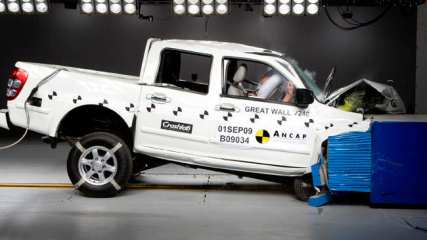
Look to the stars
Read the article
By Paul Pottinger · 12 Mar 2013
You might have seen the TV ad for a budget brand ute, the one in which the dopey looking bloke goes “d'oh” because he bought a far more expensive brand.Sure, he's down a few thousand bucks but he, his loved ones and possibly even his employer won't be so quick to self-admonishment should he survive a big prang.The chances of this happy outcome remains lower in Chinese-made working vehicles than in any from the Japanese brands, Ford, Holden or Volkswagen. Much lower in most instances.In the past month, the Australian New Car Assessment Program -- the line-filling moniker for the local agency that crashes cars into walls and rates how they hold up -- crunched the body of and the numbers on the latest such conveyance from Cathay.Foton's Tunland 4WD light-commercial dual-cab was awarded three stars from five. That's almost but not quite as poor as it gets these days, but a possibly generous assessment given the absence of electronic equipment mandatory for the full five stars.Nor is the Tunland especially cheap at $34,500. Hard to grasp why that sum shouldn't include stability control, a fixture standard elsewhere and arguably even more important for vehicles with a high centre of gravity.“There really is no excuse for a new vehicle coming into the market today to be without stability control, which is now mandatory for passenger cars,” ANCAP's Lauchlan McIntosh says.ANCAP is irksomely apt to claim credit for pushing major safety advances that originate with car makers and are compelled by market forces. Yet it has also admitted to being two years behind Euro NCAP in its methodology.There’s no quibbling on this point, however, certainly not when two such old stagers as Toyota's LandCruiser and Mitsubishi's Pajero have both been upgraded to five stars after equipment improvements.The Chinese brands fare not so well. The Chery J1 gets three stars, and the Chery J11 gets two stars. The Great Wall V240 gets two stars and X240 gets four stars. Carsguide does not recommend a vehicle of any sort that has less than four stars. Indeed, we’ve directed our team to not so much as test them. We say you shouldn’t so why should we. Some of us have families. None of us are suicidal.





